Reduction of fuel consumption on motor boats and speedboats
The keys to fuel economy
The cost of fuel consumed during the season, combined with other related expenses for the maintenance of the vessel, makes up a significant share in the family budget expenditure related to recreation. And it is safe to say that reducing fuel costs by at least one-fifth — 20% — will interest every owner of a motorboat or a boat that uses its vessel for weekend tourism, vacation travel, fishing trips.
The figure of 20% is not named by chance. Experience shows that, on average, exactly that much fuel can be saved for navigation if a set of measures is carried out to fine-tune the hull, engine and propeller, which is quite feasible for an amateur boatmaster.
Now only a novice amateur is limited to the fact that, having purchased a new boat, he hangs a new motor on its transom and goes sailing. For a more experienced person, the purchase of a new boat or motor usually means the beginning of a long and painstaking work, the ultimate goals of which will be: achieving maximum speed with minimal fuel consumption, increasing the comfort of the vessel, reliability and ease of operation of the motor.
As for the task of reducing fuel consumption, when fine-tuning the boat and the motor, they strive to ensure that the fuel is burned in the engine cylinders with the highest energy output — used for the movement of the vessel. There are several ways to successfully solve this problem — and it is important to use all of them to the end. Let's sort them out in order. So: hull, engine, propeller, competent operation and navigation.
1. Matching the engine power to the boat. Most often, the cause of excessive fuel consumption is excessive engine power that does not correspond to the contours of the boat.
First of all, this applies to tourist boats with typically displacement hull contours, converted, for example, from lifeboats or dinghies. Such vessels are designed to sail at a relatively low speed; they are characterized by round-cheeked contours with a narrowing of the waterline and the rise of the batox lines in the stern (they often have a sharp whaleboat-type stern — without a transom).
At the speed of such a vessel equal to V=5.25V—L km/h (hereafter V— is the square root), where L is the length of the hull along the waterline, m., a large transverse wave is formed, the vessel turns out to be as if pinched between its two adjacent ridges rising at the stem and in the stern. The formation of this wave — maintaining it — consumes a significant part of the power of the running engine, and hence the fuel consumed at the same time. It is not easy to overtake this wave — to break away from it: in order to increase the speed of the vessel, say, by another 10%, it will be necessary to increase the engine power by at least 1.5 times; fuel consumption will increase accordingly...
The optimal mode of operation of all boats with displacement contours is therefore sailing at a lower speed of the order of V=4V—L km/h, which can be achieved by having a power of 2 to 5 hp for every 1 ton of displacement (a large figure refers to boats with a length of along the waterline 7-9 m, in which the area of the wetted surface per meter of the length of the hull is larger and the friction resistance increases accordingly). For example, a six-oared yawl with L=5.9 m is best operated at a speed of V=4V—5.9=10 km/h with a 6-10 hp engine.; the fuel consumption per kilometer of the way will be about 350 g. To operate at a speed of 16 km/h, you will need to install a 40 hp engine on the yawl, while fuel consumption will more than double and will already be about 800 g/km.
The question of choosing the optimal mode of movement for each particular vessel is best solved with accurate data. The required figures are easy to obtain in the presence of several simple devices: a reliable speedometer, a tachometer, a measuring vessel for measuring fuel consumption, a stopwatch and a clinometer — a device for measuring the trim angle of the vessel. The speedometer can be replaced by a low pressure gauge, the scale of which has a marking in units of speed (km/h). The speed can also be calculated from the average run time of a measuring section 500 m or more long, located on a reservoir with sufficient depth (at least 4-5 vessel sediments). To neutralize the influence of wind and current, two runs are usually made one after the other — in the forward and reverse direction.
You can get complete information about the operation of the engine by making three or four runs at different numbers of its revolutions (for example, equal to 40, 60, 80, and 100% of the rated speed indicated in the engine passport). Instead of a fuel tank, a glass vessel with divisions marked on the wall is connected to the engine power supply system, which allows you to count the fuel consumption, or any vessel of an accurately measured capacity.
Hourly fuel consumption is determined by the formula:
Q = 3.6Vy/tkg/h,
where V is the volume of the measuring vessel, cm³; y is the specific gravity of fuel, g/cm³; t is the measured time of fuel consumption from the vessel, sec.
It is most convenient to present the test results visually in the form of a graph of the dependence of the speed of the vessel and the hourly fuel consumption on the engine speed. Consideration of this schedule will allow, firstly, to establish the most economical mode of movement of the vessel, and, secondly, to determine whether the propeller corresponds to the selected mode. In most cases, the graphs show that there is no point in «squeezing» full speed out of the engine at all costs, since the «last» kilometer of speed per hour is very expensive — it costs almost twice the fuel consumption!
Typical curves of the dependence of the travel speed V, hourly fuel consumption G and cruising range d (km per liter of spent fuel)
from the engine speed n for a displacement vessel with a normal power of a mechanical installation
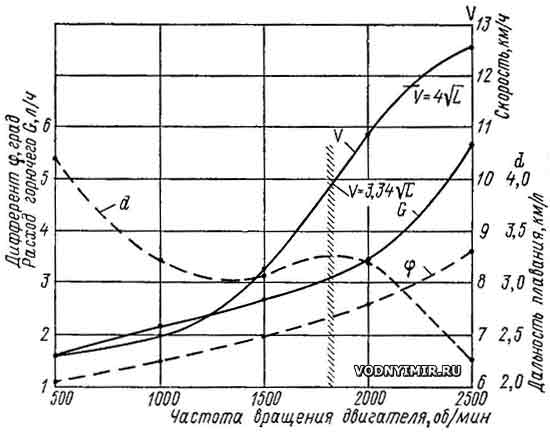
The most economical swimming mode is at 1800 rpm. A 10.2-meter motor-sailing yacht with a displacement of 5.5 tons was tested, equipped with a diesel engine with a capacity of 41 hp.
If, at the normal speed of the boat, the engine develops about 80% of the rated rpm, and the trim on the stern does not exceed 3°, it can be assumed in the first approximation that the engine power and the propeller elements are selected correctly.
The excessive engine power for this boat is indicated by too much running trim on the stern, exceeding 3-4° when the engine is running at about 75-80% of the rated rpm, and a sharp increase in hourly fuel consumption.
Excessive trim on the stern, speed exceeding 6V—L km/h, engine speed less than 70% of rated rpm with the carburetor throttle valve almost fully open and increased fuel consumption — indicate that the engine is more powerful than necessary, and the propeller «heavy». In this case, it is worth thinking about replacing the engine with a less powerful one or limiting the operating power of the existing engine and installing a step-down gearbox on the propeller shaft; then it will be necessary to choose the optimal screw. If, when the throttle is fully opened, the engine develops nominal rpm, and the speed of the boat is far from the limit of 5.25V—L km/h, this means that the propeller is «light» and it should be replaced with another screw — with a larger diameter and (or) pitch.
So far we have been talking about displacement vessels, but in the same way you should check the choice of engine (outboard motor) and planing.
Test results of a 4.1 m long planing catamaran with an outboard 25-horsepower motor
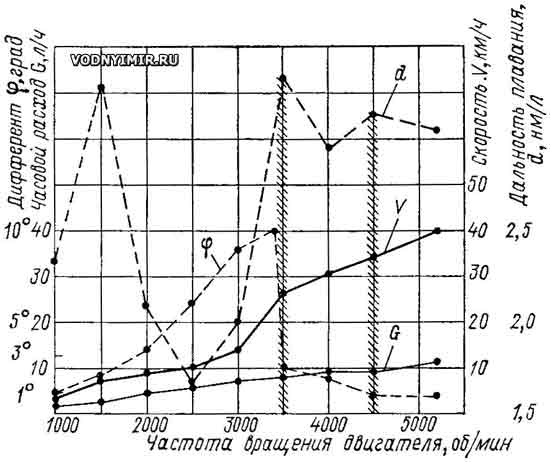
Specific load — 8 kg/hp; propeller D=237 mm, H=228 mm. The unfavorable mode at n=2500 rpm is clearly visible — the output to planing and the economic mode at n=3500 rpm, corresponding to a speed of 26 km/h.
It can be assumed that the boat starts planing at a speed of V=9V—L km/h, however, the most economical operation of a planing vessel becomes at almost twice the speed of V=15V—L km/h, when due to the action of hydrodynamic lifting forces significantly sediment, wetted bottom surface and water resistance are reduced.
If the actual speed of the boat during the tests turns out to be somewhere in the transition to planing mode, i.e. V=(6-10)V-L km/h, it may be advisable to replace the motor with a more powerful one in order to increase the speed — bring the boat to an economical speed mode above 15V—L km/h. In some cases, it is more profitable, on the contrary, to switch to displacement navigation mode using a lower-power engine. The decisive considerations here are: maximum load when sailing; the length of a typical route and the time that can be spent on its passage. If the sailing time is not limited, and the load is small, then the owner «Ladoga-2», for example, makes sense leave one 30-horsepower motor on the transom instead of the two necessary to ensure maximum speed with a passport load; on «Crimea-3» it will be possible to successfully swim under one «Breeze», etc.
2. The propeller. After the optimal engine power corresponding to the capabilities of this case is established (in the first approximation), the largest percentage of fuel savings can be obtained due to the correct selection of the propeller. Only with an optimal screw, the engine can develop nominal revolutions, while giving full power with the highest efficiency.
The owner of a light motor boat needs to get a set of replaceable screws designed for sailing with several typical load options — from the smallest, light, to full. It is necessary to check the efficiency of these screws and obtain data on fuel consumption during special tests of the boat on the measuring line.
Standard outboard motor propellers with a capacity of 20-30 hp have a pitch of 280-300 mm; this gives optimal results only on relatively fast light boats with moderate keeling of the bottom. For boats with a load of 4-5 people and for boats with increased keel of the bottom, such screws are «heavy»; the engine does not develop full power, and since at the same time they try to «squeeze out» the speed and fully open the throttle valve, the ignition advance ceases to correspond to the speed of the crankshaft, the combustion of fuel in the cylinders turns out to be incomplete.
Experience shows that the installation in such cases of lighter screws with a pitch of 260-230 mm or with blades slightly trimmed in diameter can give a speed increase of 10 to 45% (the greater the load, the greater this gain!). Accordingly, the fuel consumption per kilometer traveled also drops.
The question of selecting the optimal propeller for the vessel at a certain load is quite complicated. But under all circumstances, it is always absolutely necessary to maintain in good working order the screw that stands on the ship. Notches and bends of metal on the sharp edges of the blades, severe deformation of the blades, careless casting — all these are efficiency losses that cannot be neglected! All malfunctions must be eliminated immediately. It is advisable to carefully polish the surfaces of the new screw, having previously filed the casting protrusions (at the transition points of the hub into the blades) available on some factory-made screws.
The working conditions of the screw are also important. It is necessary that the propeller gets a stream that is not disturbed by any protruding parts of the hull — an outer keel, a thick deadwood or a propeller shaft bracket. The swirls of the flow that break off from these parts can cause the speed to decrease even twice, and sometimes three times, although the engine will develop full speed. In this case, fuel is spent on useless mixing of water saturated with air bubbles.
Little things that are «expensive»
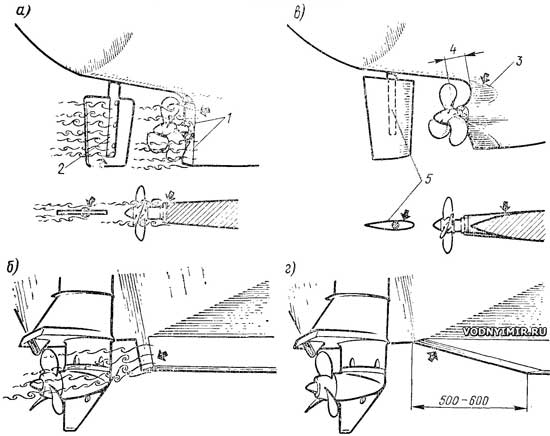
A thick deadwood on a boat (a) and a bar keel on a motorboat (b) can be sources of vortices that reduce the efficiency of the propeller. To increase the efficiency of the screw, it is necessary to give the aft edge of the deadwood a streamlined cross section, increase the gap between it and the screw, install a streamlined rudder feather (b). On a motorboat, it is necessary to cut the keel at a distance of 500-600 mm from the transom (d).
It is not difficult to neutralize the harmful effect of the external bar keel by cutting it — nullifying it — at a length of at least 500 mm from the transom, or, in extreme cases, by shifting the outboard motor from the DP to any side. On a thick deadwood, corners can be cut and rounded; sometimes it is possible to increase the distance from the blade edge to the stem. The cross sections of the bracket posts need to be given a streamlined profile, and if the bracket is made of non-corroding material, polish it. It is important that there is a gap of 15-20% D between the propeller blade and the bracket stand, and 10-20% D between the bottom and the edge of the blade, where D is the diameter of the screw.
It is worth checking whether air does not break through to the propeller hub along the rudder pen if it protrudes beyond the transom of the boat; this may cause surface cavitation of the propeller, reducing its efficiency.
3. Condition of the housing surface. The quality of the bottom finish on most even new boats is far from ideal, unless we are talking about a plastic hull molded in a polished matrix. But the roughness of the bottom, increasing the friction resistance, can significantly increase the cost of engine power for the movement of the vessel! That is why, when building or repairing a boat independently, you should not spare time for putty and subsequent cleaning of the bottom surface first with a large, and then with a fine skin. On planing boats, the aft third of the bottom needs particularly careful finishing, and on displacement boats, on the contrary, the bow half of the hull.
It is better to apply the paint with a spray gun, which gives a thin uniform layer; each layer of paint should be sanded with a fine sandpaper. The last layer should preferably be applied with antifouling paint. Since the boats are parked most of the time (most often in shallow and therefore well-warmed by the sun bays, etc.), the bottom is relatively quickly overgrown with algae and shells, especially in the southern regions of the country. After a month, the speed of the boat can decrease by 5-10% only due to fouling. Therefore, it is recommended to periodically clean the bottom with a hard brush with soap solution.
On wooden and plastic planing vessels, special attention should be paid to the condition of the sharp edges — the corners of the cheekbone and transom. If necessary, it is necessary to fill the existing potholes and bullies with epoxy putty and sharpen the edges. Every spray beam escaping upwards from under the cheekbone is an energy expenditure that you need to try to use to create additional lifting force. In some cases, it is advisable to put a splash guard or a longitudinal redan in the bow of the hull.
Similarly, to reduce the friction resistance, it is necessary to carefully process and paint the rudder pen, the underwater part of the outboard motor, the propeller shaft bracket.
4. Load. The water resistance to the movement of a planing boat largely depends on its true weight, therefore, in order to increase the actual speed and reduce fuel consumption, it is important to always operate the boat with the minimum possible load. Before each exit, it is necessary to carefully inspect the property available on the boat and leave everything superfluous on the shore, bearing in mind that every 25 kg of cargo «eats» 1 hp of engine power and about 0.5 liters of gasoline per hour! Very often they go out for short walks with an excessive supply of fuel, with empty cans, sleeping bags, tents, etc. unnecessary in this case, On many ships it is worth replacing bulky latticed wooden payoles with lightweight ones (for example, three-layer construction: made of plywood and foam).
Before leaving, do not forget to remove rainwater from the boat, because there may be more than one bucket of it!
5. Adjustment of the running trim. It is known that for every motor vessel, especially planing, there is an optimal running trim on the stern, at which the water resistance is minimal.
The value of the optimal trim for planing hulls is within very narrow limits — from 4 to 6°, depending on the contours, width and keelness of the bottom, as well as the speed of the vessel. For flat-bottomed wide hulls, the optimal trim is less; for narrow boats and boats with increased keeling of the bottom (15-23°) — more.
In the initial period of acceleration — when overcoming the «hump» on the resistance curve — the trim of the planing vessel increases greatly and may exceed 14°. If the vessel is designed correctly and equipped with a proper propeller, then when the nominal engine speed is reached, it «puts its nose» on the water — the trim decreases to the above limits. If, even with the throttle fully open, the running trim remains too large, it is necessary to take measures to reduce it. It is only by reducing the trim at full speed that it is sometimes possible to increase the speed by 40% while reducing fuel consumption by up to 20% per 1 km of travel. A slightly smaller effect is obtained in cases where it is necessary not to reduce, but to increase the initial trim to the optimum: the speed gain usually does not exceed 10%.
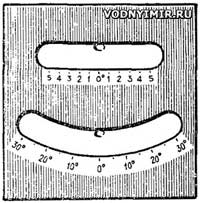 A device for measuring trim and roll angles is a clinometer. |
Practical work on adjusting the landing of the boat — trim adjustment — can be performed on a measuring line using a clinometer. The clinometer is a glass tube curved in an arc of a circle, filled with a colored liquid and equipped with an accurate scale. The movement of the air bubble in the tube indicates the trim angle. Before the start of the test runs, the clinometer is installed parallel to the waterline. Any other device can also be used (for example, based on a pendulum plumb line), which allows measuring angles with an accuracy of 0.5°.
Control runs are made at different engine speeds and different options for placing passengers and main cargo in boats. As a result, graphs are obtained of the dependence of speed on the number of revolutions for various variants of landing people and the dependence of the trim angle and hourly fuel consumption on speed. With the help of these graphs, it is possible to set the most advantageous placement of passengers, fuel reserves, camping equipment, etc. for each speed.
Typical dependencies of speed and trim changes for boats of various types
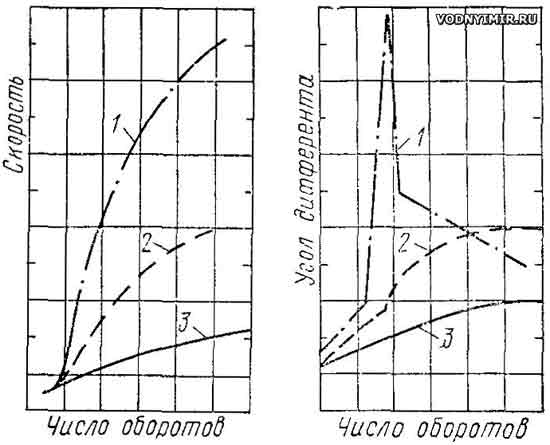
1 — planing; 2 — semi-planing; 3 — displacement.
The maximum trim occurs when the planing boat enters the design mode, then it decreases with a simultaneous increase in speed.
If the trim at full speed remains excessively large, despite all the movements of the crew and cargo, it is necessary to take constructive measures — install transom plates or retaining wedges. The best option is controlled transom plates. At the initial moment of acceleration, such plates are given a large angle of attack and thereby sharply reduce the trim; at the same time, the time for the vessel to enter the planing mode is reduced and the amount of unburned fuel ejected by the engine when overcoming the resistance hump is reduced. Upon reaching the rated engine speed, the angle of attack of the plates can be reduced.
Within a small range, the running trim can be adjusted by changing the angle of installation of the outboard motor on the transom: when the motor is pressed against the transom, the moment of forces pressing the bow of the boat to the water increases; in the case of the motor reclining from the transom, the trim increases.
Swimming of a displacement boat with a trim of more than 4-5° is unacceptable: it requires changing the contours of the stern, installing developed planing surfaces in the stern, or limiting the operational power of the engine. It is not recommended to load the extremities on such boats, since this turns the vessel into a kind of pendulum: it swings when sailing on an oncoming or passing wave, and when the amplitude of the keel pitching increases, large masses of water are involved in vertical movements near the extremities of the vessel, which again requires additional costs of engine power and fuel. Therefore, it is better to concentrate heavy loads — tanks with water and fuel, an anchor, as well as the crew as close as possible to the middle.
The effect of passenger accommodation on fuel consumption for a 7.5-meter cabin boat equipped with a gasoline engine
75 hp with corner folding column
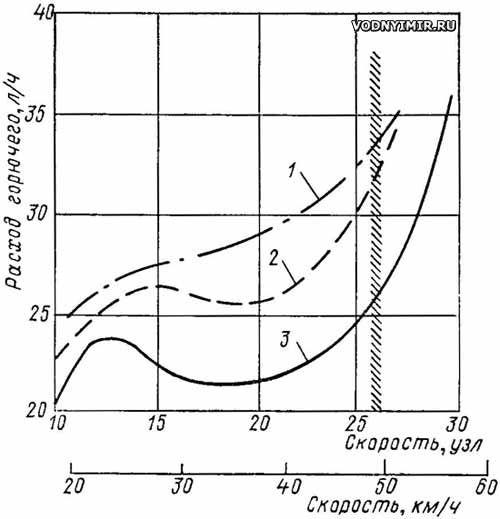
Load — 3 people:
1 — one person is sitting on the deck at the stem, two are near the middle of the boat at the control post; 2 — one person is located on the aft sofa, two are at the control post; 3 — three people at the control post; with this option, at a design speed of 26 knots, fuel consumption is about 25% lower than with the bow and stern alignment itself.
6. Engine operation. Measures to improve the efficiency of the engine should begin with the adjustment of the ignition system.
First of all, it is necessary to check the candles — their type must correspond to the recommended one for this engine; the electrodes must be serviceable, the gap must be properly adjusted. If, after a certain period of operation, the candles turn out to be heavily smoked, this means that the combustible mixture enters the cylinders too rich. If the working part of the spark plug becomes wet from fuel, it means that the ignition system is poorly adjusted or the propeller is «heavy» — with the carburetor throttle open, the engine does not develop nominal revolutions, and the fuel does not burn completely.
Then it is necessary to check the magneto interrupters, adjust their gaps and ignition timing (preferably using a strobe).
The fuel system should always be clean, there should be no air suction in the hose connections. It is necessary to check the fuel level in the carburetor float chamber and the condition of the needle valve. Excess fuel in the float chamber indicates its excessive consumption, especially at full speed. The main jet and the idle jet need careful adjustment.
A certain amount of fuel is lost when the motor reclines when approaching the shore or when pumping fuel into the float chamber of the carburetor (this, in particular, «sins» the carburetor «Vortices»). Not only is this a useless loss of fuel: the rainbow streaks on the water that remain after the boat is parked do not characterize an amateur boatmaster as a friend of nature! It is useful to make a tub for the carburetor to collect excess fuel and connect it with a rubber hose to the fuel tank. To eliminate fuel leakage through the hole in the lid of the float chamber (for the float axis), it is necessary to make a cap and glue it to the lid. In the venting hole of the lid and in the air hole of the suction system, it is necessary to insert tubes (for example, from plastic rods for ballpoint pens), bending them so that when the motor reclines, fuel does not pour out.
It is important to use only clean, fresh fuel, thoroughly and in the right ratio mixed with oil of the type recommended by the instructions. If the prepared mixture is stored for a long time, the microorganisms present in it gradually reduce the octane number of gasoline: the motor on such a mixture works less efficiently.
Carelessness is unacceptable when filling tanks and cans when fuel is spilled into the boat, on the ground or in the water.
The back pressure on the exhaust quite noticeably affects the output power of the motor. From this point of view, it is desirable that the propeller axis of the outboard motor has minimal immersion under the bottom of the boat. The lower plane of the anti-cavitation plate of the motor should coincide with the outer surface of the bottom, however, in real conditions, the motors work steadily with a slightly larger immersion of the screw, which can be determined experimentally by placing strips of various thicknesses under the clamps.
With a stationary installation, it is necessary to pay attention to the fact that the diameter of the gas outlet pipeline is sufficient, and its resistance to the movement of exhaust gases is minimal.
7. The choice of economic speed. Economic speed is the main mode of operation of the vessel.
As a rule, a carburetor engine is most economical when operating at 60% of maximum power (namely power, not RPM). This corresponds to the opening of the carburetor throttle at 1/2-2/3 full throttle. For an outboard motor with a rated speed of 5000 or 4500 rpm, the economy mode will correspond to approximately 4000 and 3600 rpm. It is in this mode that long-term operation of the motor is recommended, ensuring maximum cruising range. More precisely, the mode of economic speed can be determined from the data of experimental runs at a measured distance, as described above.
In the daily operation of a boat, a certain amount of fuel can be saved with fairly frequent departures from the shore and approaches to it.
Having started the engine, it makes no sense to drive it idling for a long time — you can immediately turn on the reverse.
On a planing boat, it is enough to open the throttle completely only for the time of planing; as soon as the boat has adopted a normal running trim, you can remove the gas to the economic mode.
Displacement boats are gaining speed slowly, so you need to open the throttle gradually, otherwise in the cylinders of the engine working with overload, part of the fuel will not burn and will be ejected from the carburetor diffuser. Similarly, it is also necessary to gradually release gas when approaching the shore. It is not necessary, for example, to turn on the reverse gear, abruptly give full throttle. It is better to reverse in advance, gradually increasing the speed, or, turning on the neutral, go idling until inertia is lost and only then work out reversing at low speeds.
8. Navigation. Quite a significant fuel economy (especially in long-distance sailing) can be obtained by intelligently steering the boat.
When choosing a route, it is advisable to avoid areas where the wind and current will act against the movement of the vessel, where the vessel may encounter a large wave. It should be used to protect the relief of the coastal part from the wave, hiding behind capes and islands. With a strong crosswind, it is better to stay closer to the leeward shore.
Going up against the current on the river, it is worth staying closer to the shallow shore and in the «shadow» of the capes, where the current is weaker. When sailing down the river, on the contrary, it is worth sticking to the rod.
Unnecessary course changes not only lengthen the path, but also cause short-term speed drops, fuel consumption increases noticeably.
Fuel economy is also provided by the use of sails, especially on displacement boats. The sail will be useful not only in a strong tailwind for the direct movement of the boat without fuel costs. In combination with the operation of the engine, it allows you to unload the propeller and slightly increase its efficiency, especially if the rotational speed of the propeller shaft exceeds the recommended 1000 rpm for every 15 km/h speed. In addition, the sail stabilizes the boat on course. It is not for nothing that in recent years sails have reappeared in the projects of fishing and even transport vessels.
In an open reservoir, a headwind and a wave can force the skipper to slow down. In this case, it is useful to remember that outboard motors at low speeds usually consume fuel for 1 km of travel relatively more; you can stay in the middle of the reservoir without fuel.
In the section «Motorboats, boats, yachts — miscellaneous, reviews, tips»
Share this page in the social. networks or bookmark:
